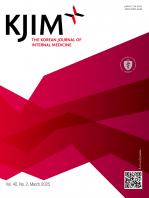|
Allergy / Original Article
Retinol-binding protein-4 was associated with sensitization to inhalant allergens in the elderly population
Byung-Keun Kim, Woo-Jung Song, Bomi Seo, Ju-Young Kim, Sae-Hoon Kim, Hak C. Jang, Ki-Woong Kim, Yoon-Seok Chang
Korean J Intern Med. 2021;36(2):447-455. Published online October 13, 2020
Background/Aims: Recent evidence suggests an association between allergic sensitization and metabolic markers. However, this association has rarely been examined in the elderly. Retinol-binding protein-4 (RBP-4) is a recently identified adipokine that acts on the muscle and liver affecting insulin s..
|
|
|
Nephrology / Original Article
Urinary tissue inhibitor of metalloproteinase-2 and insulin-like growth factor-binding protein 7 as biomarkers of patients with established acute kidney injury
Won Yong Cho, Sung Yoon Lim, Ji Hyun Yang, Se Won Oh, Myung-Gyu Kim, Sang-Kyung Jo
Korean J Intern Med. 2020;35(3):662-671. Published online December 23, 2019
Background/Aims: Urinary tissue inhibitor of metalloproteinase-2 (TIMP-2) and insulin-like growth factor-binding protein 7 (IGFBP7) have been recently discovered and validated as sensitive biomarkers that can predict stage 2 or 3 acute kidney injury (AKI) development in high-risk patients. We aimed ..
|
|
|
Endocrinology-metabolism / Original Article
Adipokines, insulin-like growth factor binding protein-3 levels, and insulin sensitivity in women with polycystic ovary syndrome
Hyejin Lee, Jee-Young Oh, Yeon-Ah Sung
Korean J Intern Med. 2013;28(4):456-463. Published online July 1, 2013
Background/AimsMany women with polycystic ovary syndrome (PCOS) exhibit insulin resistance. Adipose tissue plays an important role in insulin resistance, and adipokines including tumor necrosis factor (TNF)-α and adiponectin are altered in PCOS. Insulin-like growth factor bin..
|
|
|
Original Article
Nuclear factor E2-related factor 2 Dependent Overexpression of Sulfiredoxin and Peroxiredoxin III in Human Lung Cancer
Young Sun Kim, Hye Lim Lee, Ki Bum Lee, Joo Hun Park, Wou Young Chung, Keu Sung Lee, Seung Soo Sheen, Kwang Joo Park, Sung Chul Hwang
Korean J Intern Med. 2011;26(3):304-313. Published online September 13, 2011
Background/AimsOxidative stress results in protein oxidation and is implicated in carcinogenesis. Sulfiredoxin (Srx) is responsible for the enzymatic reversal of inactivated peroxiredoxin (Prx). Nuclear factor E2-related factor 2 (Nrf2) binds to antioxidant responsive elements..
|
|
|
Original Article
Diagnostic Value of a Chimeric TSH Receptor (Mc4)-Based Bioassay for Graves' Disease
Ji In Lee, Hye Won Jang, Soo Kyoung Kim, Joon Young Choi, Ji Young Kim, Kyu Yeon Hur, Jae Hyeon Kim, Yong-Ki Min, Jae Hoon Chung, Sun Wook Kim
Korean J Intern Med. 2011;26(2):179-186. Published online June 1, 2011
Background/AimsGraves' disease (GD) is caused by thyroid-stimulating hormone receptor (TSHR) and thyroid-stimulating immunoglobulin (TSI). We used a recently introduced, technically enhanced TSI bioassay to assess its diagnostic value and determine the cut-off in patients in h..
|
|
|
















